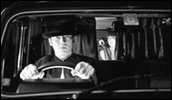Rampo Noir
- Year
- 2005
- Original title
- Ranpo Jigoku
- Japanese title
- 乱歩地獄
- Director
- Cast
- Running time
- 134 minutes
- Published
- 22 December 2005



by Jasper Sharp
Bored of J-horror yet? Does it seem that the raw nerve touched by the original Ring almost a decade ago is now a burnt-out synapse dulled by repetition? Why do these works from the country whose output at first glance seems so perfectly to fit the "Asian Extreme Cinema" label now seem so shoddy and pedestrian? Ok, so Takashi Shimizu's The Stranger from Afar offered a flash of promise last year, but what Japanese horror really needs right now is a whole lot more fuel to its fire if it's not to fizzle out entirely.
Call me shallow, but I like my horror served hot, not lukewarm, and I for one hope that this endless succession of pallid young girls crawling out of screens towards the viewer, hair smeared sweatily to foreheads, with the stiff jerky movements of a Butoh dancer, has run its course by now. After all, the generation of viewers won over by Nakata's films has long grown up or tuned over to the Hollywood remakes, and with prices of cinema tickets in Japan as high as they are, you'd have thought producers would have found another more lucrative market to tap into than high-school girls.
Once upon a time, before Sadako climbed out of her well, Japanese fantasy was a world characterised by exuberance and excess. Titles such as The Blind Beast, The Horror of Malformed Men, and Watcher in the Attic gave explicit vent to that which was often only hinted at in other nations' cinemas. Rather than concern themselves with pent-up supernatural forces lying suppressed beneath the austere and drab veneer of the organised and highly rational modern world, they unfolded in worlds governed by their own more primal logic situated far away from the mundanity of everyday life.
Arriving just in the nick of time to breathe life into this increasingly moribund genre, Rampo Noir turns back to the original source of many of these earlier nightmares, the works of mystery writer Edogawa Rampo. Rampo's writings had been fuelling the national cinema long before horror had become an established genre in Japan, with the silent version of Issunboshi (The Killer Dwarf) directed by Seika Shiba and Sanjugo Naoki way back in 1926 being the first adaptation, followed by Daiei Studio's The Palette Knife Murder (Paretto Naifu no Satsujin) directed by Seiji Hisamatsu in 1946.
But by the time Shochiku offered up their own fictionalised and thoroughly unconventional take on the writer's life to celebrate the 100th anniversary of his birth in the 1994 film Rampo, it seemed there was little mileage to be gained from further explorations of his themes. The pendulum had come full swing when Shinya Tsukamoto's Gemini hit screens in 1999, by which time the local horror scene had reinvented itself along altogether different, more subdued lines. Subsequent adaptations of Rampo's work have rarely registered as blips on the radar. Teruo Ishii's cut-price Blind Beast vs. Killer Dwarf (Moju VS Issunboshi), a self-produced DV-shot offering featuring director Tsukamoto in the lead role, sat on domestic shelves for several years until a minor theatrical release in Tokyo in 2004.
Rampo's short stories, like those of Edgar Allan Poe, the American mystery writer from whom he took his non-de-plume, lend themselves incredibly well to cinematic treatment in that they are driven by imagery rather than plot. Just as Roger Corman span out a whole series of lusciously atmospheric titles in the 1960s that borrowed only the salient elements from Poe's short tales like The Pit and the Pendulum and The Fall of the House of Usher, directors in Japan have constantly found themselves turning back to Rampo's stories.
All the best then that the omnibus movie Rampo Noir sees two of Japanese cinema's most extreme and visually expressive cinematic reprobates reintegrated into the fold, as well as welcoming in two newcomers to the movie world who have cut their teeth in their own respective fields within the image industry. The tone for the next two and a quarter hours is set in the opening moments with the feverishly-shot and deathly silent Mars Canal (Kasei no Unga) from pop-promo and TV ad director Suguru Takeuchi. A non-narrative piece serving to splice the three main tales together, it depicts a stark naked Tadanobu Asano staggering across a barren wilderness before collapsing at the rim of a crater lake and descending into a world of nightmares.
Asano crops up again in the first of three main stories, Mirror Hell (Kagami Jigoku), in the role of Detective Kogoro Akechi, a recurrent character throughout much of Rampo's writing, here investigating a string of beautiful women's corpses all of which are linked back to a mad mirror maker. Like the other three segments, it plays loosely with its source material, but retains the original short story's memorable set piece in which Akechi's nemesis drives himself insane by sealing himself inside a sphere with a mirrored interior where his narcissistic obsessions trigger his doom. The episode is directed by the much-overlooked Akio Jissoji, whose career has stretched from ATG-produced art movies such as This Transient Life and Mandala (1971) through one of the many Ultraman features (in 1979) to the De Sade-inspired The Glory of Vice (Akutoku no Sakae) for Nikkatsu in 1988. No stranger to the works of Rampo, Jissoji also gave the world his own version of Watcher in the Attic in 1994 and D-Slope Murder Case in 1998. Shooting in cold muted colours and, true to form, gratuitously inserting a rather strong SM sequence, Jissoji's episode looks absolutely beautiful as he makes full visual capital from the reflective possibilities of the story to fill the screen with some extraordinary compositions.
Anyone who remembers the truly nauseating scene of self-cannibalisation that capped Hisayasu Sato's 1997 straight-to-video movie Splatter: Naked Blood (1996) - and let's face it, it's a pretty difficult one to forget - might have doubts about the wisdom of letting this particular director loose on one of Rampo's most grotesque stories, The Caterpillar (Imomushi). The tale features a wounded war veteran who returns from the frontline as little more than a bloody torso, "a pathetic broken doll whose limbs were cruelly torn off by the playful gods of war", helpless to defend himself against the increasingly perverted caprices of an embittered wife. Fifteen years plying his trade in the pink industry have hardly fostered much in the way of restraint in Sato, but this is the first time that he's had the budget at his disposal to indulge his macabre imagination to the full. With Sato's reputation for excess enough to keep more commercially-minded producers at bay, this is a particular welcome return to the big screen after far too many years spent in the wilderness. This fearsome episode is so powerfully realised it could either see the director embraced as the genuine visionary that he is or banished from the filmmaking world for good. We can only hope it's the former.
Crawling Bugs (Mushi), the final segment is another filmmaking debut, this time from manga artist Atsushi Kaneko. The episode centres around a chauffeur (again played by Asano) who becomes infatuated with the actress he is employed to ferry around. While every story in this omnibus looks absolutely stunning in its own right, this final episode has to be the most idiosyncratic of the lot. Realised in sickly, supersaturated hues to make the most of its ultra-kitsch retro designs, the story wanders into the boundaries of the surreal.
This final segment highlights the most overwhelming impression on viewing Rampo Noir. With such a lavish budget and huge amount of creative leeway afforded to every one of the four directors and the presence of such big names in the cast as Asano and Ryuhei Matsuda, what immediately jumps out is just what a preposterously bold undertaking this whole project is. From the results onscreen, the risk has quite clearly paid off: it has been a long while since I saw anything coming from Japan that looked this good.
Rampo Noir is a reminder of many of the things that attracted many of us to Japanese exploitation cinema in the first place: its unabashed eroticism, its remarkable visual inventiveness, and its willingness to plunge into the dark realms that so many other movies fail to explore. Unfortunately these aspects may well prove problematic in getting the film screened more widely, because it also presents us with some pretty strong images to take home, all the more shocking in a film of this budget and scale. Rampo Noir received an R-15 certificate back in Japan, though I doubt other countries' censors are going to be quite so lenient.
Still, with the waning J-horror boom, characterised by high-concept plotlines and a gloomily restrained mise-en-scène, currently running on empty, Rampo Noir's hallucinogenic approach to narrative and visuals is nothing short of invigorating. While its frequent forays into the boundaries of bad taste mean we'd all be advised not to hold our breath waiting for the Hollywood remake, the vivid imagination of Japan's literary master of the macabre has rarely been served better.